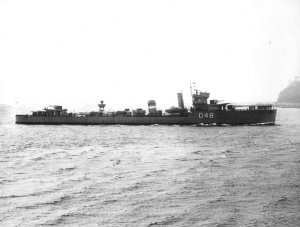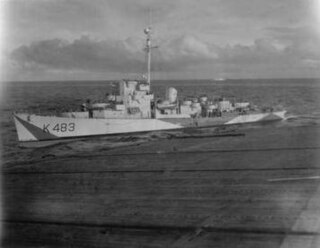
HMS Vidette (D48) was an Admiralty V-class destroyer of the Royal Navy. Built at the end of the First World War, she served in the final months of that conflict, and saw extensive service in the inter war years and in World War II. She was an effective convoy escort and U-boat killer, being credited with the destruction of five U-boats during the Battle of the Atlantic. HMS Vidette transported Spike Island Republican Prisoners to Bere Island Internment Camp in 1921. *Refer Spike Island’s Republican Prisoners, 1921 by Tom O’Neill MA.

HMS Kempthorne (K483) was a Captain-class frigate of the Royal Navy and named after Captain John Kempthorne of HMS Mary Rose in 1669.

HMS Woodpecker, pennant number U08, was a Black Swan-class sloop of the Royal Navy. She was active during the Second World War and was a successful anti-submarine warfare vessel, being credited with the destruction of six U-boats.

HMS Arbutus was a Flower-class corvette of the Royal Navy, which was active during the Second World War. She was a successful escort vessel, and took part in the destruction of two U-boats during the Battle of the Atlantic. Arbutus was sunk in the North Atlantic in February 1942.

HMS Balfour was a Captain-class frigate of the Royal Navy which served during World War II. She was built as a TE (Buckley) type destroyer escort in the United States and delivered to the Royal Navy under the Lend-Lease arrangement.

HMS Aylmer was a Captain-class frigate of the Royal Navy that served during World War II. The ship was named after Matthew Aylmer, commander of HMS Royal Katherine at the Battle of Barfleur in 1692 during the War of the Grand Alliance.

HMS Conn was a TE ("Buckley") Type Captain class frigate of the Royal Navy. She served during World War II as a convoy escort and anti-submarine warfare vessel in the Battle of the Atlantic and was credited with the destruction of two U-boats during the conflict.

HMS Duckworth (K351) was a Captain-class frigate of the Royal Navy. She served during the Second World War as a convoy escort and anti-submarine warfare vessel in the Battle of the Atlantic and was an effective U-boat killer, being credited with the destruction of five U-boats during the conflict.

HMS Keppel was a Thornycroft type flotilla leader built for the Royal Navy at the end of the First World War. She was completed too late to serve in that conflict, but saw extensive service in the inter war years and in World War II. She was an effective convoy escort and U-boat killer, being credited with the destruction of five U-boats during the Battle of the Atlantic. She was the second of three ships named for 18th century Admiral Augustus Keppel.
HX 237 was a North Atlantic convoy of the HX series which ran during the Battle of the Atlantic in World War II. It was one of several convoy battles that occurred during the crisis month of May 1943.

Arctic naval operations of World War II were the World War II naval operations that took place in the Arctic Ocean, and can be considered part of the Battle of the Atlantic and/or of the European Theatre of World War II.
German submarine U-354 was a Type VIIC U-boat of Nazi Germany's Kriegsmarine during World War II.

HMS Stork (L81) was a Bittern-class sloop of the Royal Navy. She was active during the Second World War, serving in convoy escort groups, and was a successful anti-submarine warfare vessel, being credited with the destruction of four U-boats.

HMS Wanderer (D74/I74) was an Admiralty modified W class destroyer built for the Royal Navy. She was the seventh RN ship to carry the name Wanderer. She was ordered in January 1918 to be built at the Fairfield Shipbuilding and Engineering Company, Govan in Glasgow, being launched in May 1919. She served through World War II where she was jointly credited with five kills on German U-boats, more than any other ship of her class. In December 1941 the community of Sutton Coldfield in Warwickshire officially adopted her. In 1943 she was one of twenty one V&W class destroyers to be converted as Long Range Escorts. She was decommissioned after the war and sold for scrap in 1946.

HMS Ekins (K552) was a British Captain-class frigate of the Royal Navy that served during World War II. Originally constructed as a United States Navy Buckley class destroyer escort, she served in the Royal Navy from 1943 to 1945.

HMS Wren (U28) was a Black Swan-class sloop of the Royal Navy. She was active during the Second World War and was a successful anti-submarine warfare vessel, being credited with the destruction of five U-boats.

HMS Pelican (L86) was an Egret-class sloop, built for the British Royal Navy. She was active during the Second World War and was a successful anti-submarine warfare vessel, being credited with the destruction of four U-boats.

Clive Gwinner (1908–1998) was a Royal Navy officer who served during the Second World War. He was a successful Anti-Submarine Warfare commander, being credited with the destruction of seven U-boats during the Battle of the Atlantic.

HMS Lagan (K259) was a River-class frigate of the Royal Navy (RN). Lagan was built to the RN's specifications as a Group II River-class frigate. She served in the North Atlantic during World War II.

HMS Mourne (K261) was a River-class frigate of the Royal Navy (RN). Mourne was built to the RN's specifications as a Group II River-class frigate. She served in the North Atlantic during World War II.


















